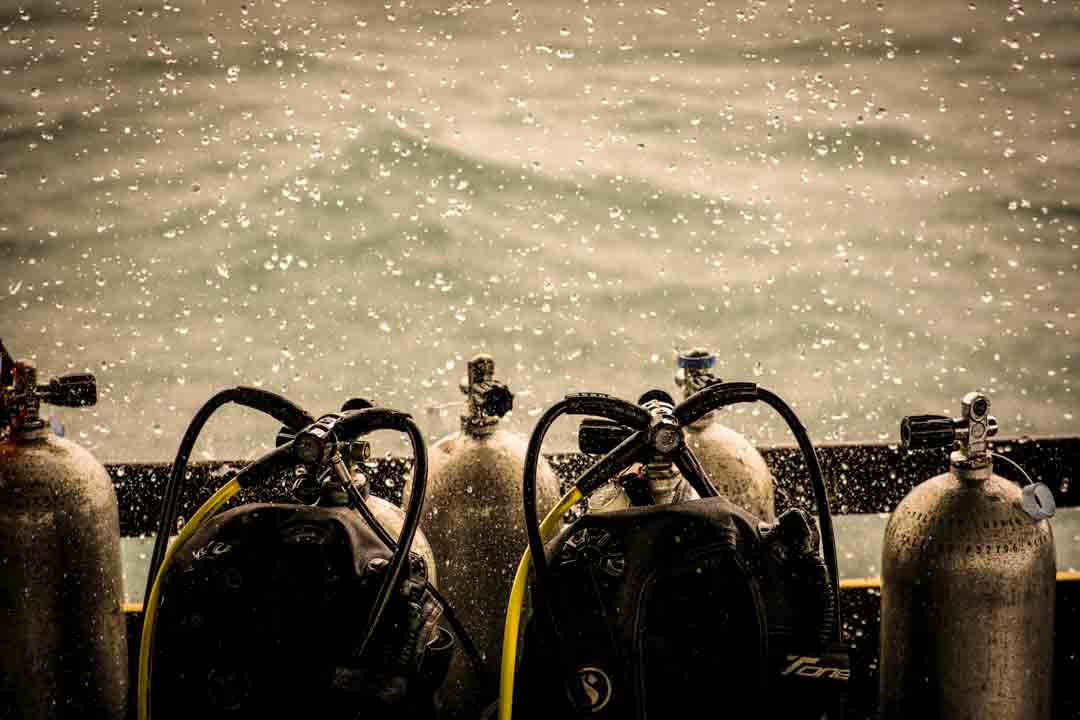So, you’ve decided that you want greater flexibility in when, where, or for how long you dive. Why would this matter to you? Does owning a personal tank make that much difference to your diving lifestyle? These are some of the questions we’ll discuss in this scuba tank buyer’s guide.
We’ll start with the most asked Q&A: What’s the difference between steel vs aluminum scuba tanks? What are the best scuba tank sizes? Together with; how long a scuba tank will last, how much does a refill cost, and do cheap scuba tanks actually exist?
ALL THE SCUBA TANKS THAT WE TESTED
FABER FX Series 100
General Impression
It’s hard to know where to start with this steel 100 scuba diving tanks. It means business; whether that’s as a dive professional who teaches or guides, or deep underwater for commercial practices, this is the scuba tank you want. With 100cf at high-pressure, this scuba tank will not just get the job done, but you’ll never have to worry about running out of air. Standard white scuba diving tank color for air, just add your EAN wrap for Nitrox and you’re good to go!
Specifications
CAPACITY: 100cf
MATERIALS: Blue Steel
MEASUREMENTS: 29” x 7.24”
WEIGHT: 36 lbs
MAX FILL PRESSURE: 3442 PSI / 237 Bar
VALVE TYPE: Pro K Valve
NITROX COMPTABILE: Up to 40%
BUOYANCY: Full: -9.41lbs, Empty: 2.2lbs
PROS
- FX series approved by DoT and TC
- Self-draining boot, and DIN/Yoke valve included
- Corrosion resistant finish
- High-pressure and max capacity for serious divers
CONS
- Pricey
CATALINA Pony Bottle Tank
General Impression
One of the overall bestsellers on the market is the Catalina 80 CF Aluminium. It’s so popular that it’s widely used in dive training and chances are, you’ve already used one. It has its proprietary Pro Valve that can be used with DIN or Yoke valve. It comes nitrox ready up to 40% and has a working pressure of 3000 psi (200 bar).
Specifications
CAPACITY: 6.0 – 40 cf
MATERIALS: Aluminium alloy
MEASUREMENTS: 4.38″ x 17.40″
WEIGHT: 7.8 lbs
MAX FILL PRESSURE: 3000 psi / 207 bar
VALVE TYPE: Pro Valve
NITROX COMPTABILE: up to 40%
BUOYANCY: -1.3 lbs
PROS
- Pro Valve (DIN or Yoke)
- Working pressure of 3000 psi (200 bar)
- Nitrox Ready up to 40%
CONS
- No hydro/air fill
CATALINA 80 CF Aluminium
General Impression
The Catalina Pony Bottle scuba diving tank is a must-have either as an addition to your main scuba tank or as a substitute for shallow dives. The pony bottles have their own regulators for 1st and 2nd stages which is why a lot of divers use them for out-of-air scenarios. For shallower, recreational dives, you can get the 6, 13, or 19 cu ft cylinders. For more technical and deeper dives the 30 and 40 cu ft cylinders should be enough. They all come nitrox ready up to 40%.
Specifications
CAPACITY: 80cf
MATERIALS: Aluminium
MEASUREMENTS: 28.8″ x 7.25″
WEIGHT: 31.6 lbs
MAX FILL PRESSURE: 3000psi (200bar)
VALVE TYPE: Pro Valve
NITROX COMPTABILE: up to 40%
BUOYANCY: -1.8 lbs.
PROS
- Compact size
- 1st and 2nd stages regulators
- 5 different sizes
- Pro Valve
CONS
- Not set up for DIN
SPARE AIR Scuba Tank
General Impression
Much like skydivers need a spare parachute, divers need spare air. It’s a different choice than the rest of the scuba diving tanks on this list. It’s not something anyone wants to need, but it’s certainly something that could save your life. The Spare Air Scuba Tanks are so light and compact you’ll have no excuse for forgetting at home when traveling. It’s easily refillable from other scuba tanks.
Specifications
CAPACITY: 6.0 cf
MATERIALS: Aluminum – Black Anodized
MEASUREMENTS: 13.5″ x 3.2″
WEIGHT: 3.7 lbs
MAX FILL PRESSURE: 3000 psi / 207 bar
VALVE TYPE: Balanced single stage regulator
NITROX COMPTABILE:
BUOYANCY:
PROS
- Compact, slim, and lightweight
- Refillable from other scuba tanks
- Easy to travel with
CONS
- Pricey for the product
FABER High Pressure Steel Tank
General Impression
Faber scuba tanks are an industry standard steel scuba tanks seen across the globe at a myriad of dive shops and liveaboards. Comes in a variety of scuba tank sizes; the small scuba tanks are ideal for shorter divers on twinsets or those side mounting.
Specifications
CAPACITY: 40cf
MATERIALS: Steel
MEASUREMENTS: 5” x 7.25”
WEIGHT: 7 lbs
MAX FILL PRESSURE: 3442 PSI / 237 Bar
VALVE TYPE: Pro K Valve
NITROX COMPTABILE: Up to 40%
BUOYANCY: Full: -9.41lbs, Empty: 2.41lbs
PROS
- Nitrox ready out of the box, up to 40%
- Excellent for buoyancy using back inflation
- K-type valve for DIN/Yoke regulator
CONS
- Only comes in one colour
FABER 80
General Impression
Booyah! Who’s going pro? You are, with these scuba diving tanks! There are no two ways about it, this is when scuba tanks get real. A high-pressure tank that’s compatible with any regulator in the industry. It comes Nitrox ready, up to 40%, and has a durable corrosion resistant finish.
Specifications
CAPACITY: 80cf
MATERIALS: Blue Steel
MEASUREMENTS: 25” x 7.24”
WEIGHT: 28.6 lbs
MAX FILL PRESSURE: 3442 PSI / 237 Bar
VALVE TYPE: Pro K Valve
NITROX COMPTABILE: Up to 40%
BUOYANCY: Full: -8.05lbs, Empty: 1.74lbs
PROS
- Great size/weight/pressure design
- Nitrox ready up to max recreational limits
CONS
- Only comes in one color
BEST SCUBA TANKS
Buyer's Guide
Steel vs Aluminum
It sounds like the title of the next Superman movie, doesn’t it? In actuality though, trying to make that decision about which scuba tanks are better for your needs can feel like buying scuba tanks is a super-human feat.
So, here’s the low-down.
Aluminum:
Aluminum has a lower tensile strength, which means the walls will be thicker to compensate. As such, the extra thickness then makes aluminum scuba tanks heavier than steel in a like for like comparison. A result of this construction is that aluminum scuba tanks are generally a fraction larger than steel scuba tanks in their overall dimensions. This may sound like a certain downside; however, this means aluminum scuba diving tanks are negatively buoyant when full. This allows your tank to change over to a positive buoyancy throughout your dive. It is reassuring to know that when your dive is done your tank will float!
Aluminum scuba tanks are the most common tank used for dive shops. They’re also cheaper than other scuba tanks for sale, which is why dive shops have so many. Why are they cheaper? Because aluminum scuba diving tanks have a shorter lifespan, due to their tensile strength which means they’re more likely to dent, scratch, or crack. However, they are also easier to maintain and are less susceptible to corrosion.
Steel:
The heavy-duty characteristic of this metal allows the tank walls to be thinner, making steel tanks slightly lighter in weight than their aluminum counterparts. Steel tanks have greater durability, are less likely to suffer from wear and tear, but this increases with exposure to saltwater. This corrosion means steel scuba tanks need regular servicing, cleaning, and may require tumbling to remove oxidation from inside.
As for buoyancy, the good news is that steel tanks are negatively buoyant at the start of a dive, and they won’t change much throughout the dive. Steel scuba tanks, even when empty, retain a degree of neutral buoyancy, but only just, which means finding your trim is straightforward and won’t change much.
Is one better than the other? Not really, as they both have the same visual and hydrostatic inspection requirements. Which tank is best for you depends more on the type of diving you do, and your physical build – see below for sizing.
Why haven’t we mentioned the new kid on the block, the carbon fiber scuba tank? Well, our research has shown that although some US Navy divers (US Department of Transport) have had promising dive experiences with these tanks due to their high-pressure capabilities, as yet most carbon fiber scuba tanks are not Department of Transport or Transport Canada approved – meaning there are still some causes for concern.
The only carbon fiber tank we know of that is being sold for scuba purposes is made by Luxfer, and has been granted a special permit to do so (DoT Pipeline and Hazardous Materials Safety Administration). However, we are unaware of any other carbon fiber DoT or TC approved scuba tank for recreational diving, only to supply air for air-guns, etc. As such, we would caution any diver considering these tanks as there are potential risks and many dive shops may not refill them as a result.
The other problem with carbon fiber scuba tanks is that as they are made of a super-lightweight composition your buoyancy will need a major overhaul. This type of tank is significantly positively buoyant, so you’ll need to wear a large amount of lead to remain neutrally buoyant while diving.
Size/Weight/Capacity
Once you know which type of tank you want, the next important consideration is size. The first thing to consider is your physical build, and what’s going to be comfortable for you to wear. Shorter scuba divers might want to consider a steel 80cf tank over aluminum, as the tank itself will be smaller for the same amount of oxygen.
Equally, if you’re a female diver, you may wish to consider a longer cylinder as they have been known to aid buoyancy due to sitting lower over the hips. Ladies, it’s worth noting that tanks will have a significant effect on your buoyancy in connection to your exposure suit, you can find out more about women’s wetsuits here.
Either way, it’s worth remembering that you should be able to comfortably carry your tanks when on land. If you’re looking to buy a complete setup, tank, and BCD, then check out this link for advice on men’s and unisex BCDs.
Tank capacity is calculated by its size and pressure rating. Tanks generally range between 50cf and 120cf. There are three pressure ranges: low-pressure (LP) at 2400-2650psi, standard pressure at 3000psi, and high-pressure (HP) at 3300-3500psi. What does that mean? Put simply, the higher the psi the thicker the walls of your tank.
What’s the difference between LP and HP, other than numbers? There are advantages to both. LP tanks are more readily refilled as there are plenty of dive shops equipped to fill them. LP tanks also put less stress on your regulator and valve components – although, this is now less of a concern with modern HP tanks. HP tanks can hold more air, and a steel HP tank means you’ll be diving for longer with a smaller tank on your back!
One alternative is a compromise; a high capacity HP steel tank, and routinely not filling it to capacity. That way you have plenty of gas to dive, but lessen the risk of damage to your equipment, and you can always fill it right up when you need to!
Tank Lifetime & Underwater
This will vary between manufacturers and diver use. A tank that’s used daily and treated poorly will last a shorter time due to knocks, scratches, and general mistreatment. A tank that’s handled carefully, that has a boot or mesh protector, and is stored appropriately will fair much better.
However, no matter what sort of tank you have, you should always ensure that it has a maintenance routine which includes both visual and hydrostatic inspections, most federal regulations require tanks to be requalified every 5 years for solid wall tanks, so make sure your tank is in date! If you’re thinking about diving with EAN, then you’ll need an extra step, an O2 clean to keep you safe.
Refilling
Filling up scuba tanks sounds like it should be easy, right? Just hook it up to a compressor and that’s it. Wrong.
A common misconception is that diver’s breath just oxygen underwater. We don’t, it’s usually a mix of nitrogen and oxygen, with small amounts of other gases. Using a compressor that isn’t designed for scuba could leave you breathless… or worse.
Compressors that are commonly used in garages or workshops are less likely to have air filtration systems on them, meaning the air that comes out the end isn’t ‘clean’. If you put that in your tank, when you’re 100ft down it’ll be like sucking on the tailpipe of your car. Tasty, and potentially fatal.
So what alternatives are there? Only buy refills from reputable dive shops! If you have any doubts, ask to see their certification, all filling points must have a regular maintenance schedule and be certified to fill tanks. How much will it cost to refill? Roughly the cost of a cup of decent coffee, $3-5, less if they offer a loyalty scheme.
You could also consider purchasing your own scuba compressor. Just imagine, you can fill up whenever, wherever, and never have to queue again. Just be prepared to outlay some cold-hard cash to do so!
Buying Scuba Tanks
Now, the hard bit, where to buy your next scuba tank, and how much to pay. There are several options here, if you’re keen to buy secondhand you can check online, or your local newspaper’s classified section for scuba tanks for sale.
Alternatively, online auction sites also regularly list scuba tanks, and some sellers will encourage inspection before bidding. However, if you want a new tank, then either your local dive shop, online dive shops, or of course other online sellers.
As part of this buyer’s guide and review, we’ve included the 8 best scuba diving tanks we know are on the market.
As to price, scuba tank prices can vary a lot. There’s no such thing as an ‘excellent, near new, cheap’ tank, not unless you’re the luckiest person in the world. Realistically, to get the best scuba tank deal for you, work out what sort of tank you want, what your budget is, and go hunting. Be prepared to make a significant financial investment in your new tank, cheap tanks can retail at around $120-150, and expensive ones are often 3-4 times that.
REACH OUT
As always, we create our content with you, fellow adventurers, in mind. So, how’d we do? Did you find this informative? Did it help you make a decision? Did we miss anything? We’d love to hear from you below. Thanks for reading and we hope your next adventure is a great one!

























